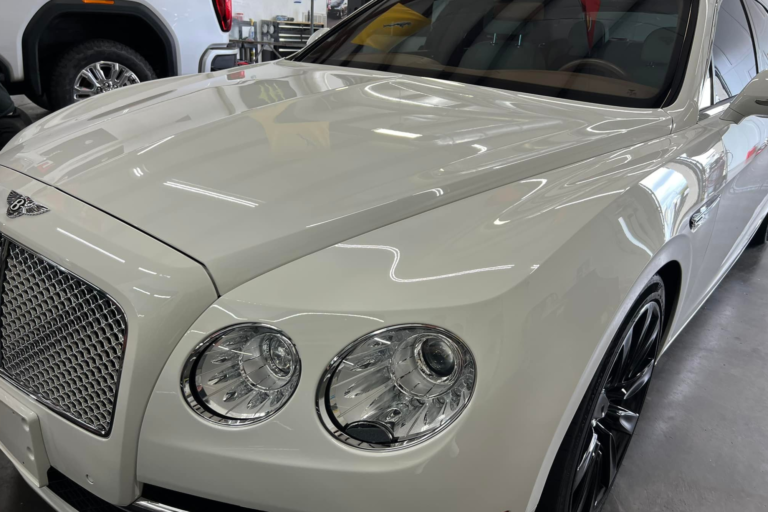The silent killers of your car’s paint aren’t just obvious scrapes or collisions but rather environmental factors that stealthily degrade the appearance and value of your vehicle over time. These culprits range from sun exposure, which can cause oxidation and fade your paint, to acid rain and bird droppings that dull your car’s finish. Even road salt during winter can corrode the lustrous exterior. By proactively maintaining your car with frequent washing, applying protective coatings, and adopting smart parking habits, you can combat this cumulative damage. Rest assured, further discussion provides effective home remedies and professional services to refresh your car’s paintwork.
Key Takeaways
- Environmental factors like sunlight, acid rain, bird droppings, and road salt are silent killers of car paint.
- Damage to car paint accumulates over time, leading to visible deterioration and reduced vehicle value.
- Vulnerable areas include horizontal surfaces, front areas, wheel wells, and lower side panels, requiring special attention.
- Regular washing, application of protective coatings, and smart parking habits can help prevent paint damage.
- Severe damage may require professional restoration services, which use high-quality materials and guarantee quality work.
Identifying the Silent Car Paint Killer
When you think about threats to your car’s paint, accidents or deep scratches might come to mind. However, the real enemy is far more deceptive.
- UV rays & oxidation – Sunlight causes oxidation, making paint fade and lose its vibrant finish.
- Acid rain – Contains pollutants that create corrosive reactions on your car’s surface.
- Bird droppings & tree sap – These contain acidic compounds that, if left unattended, eat through the clear coat.
- Road salt & debris – Common in winter, salt accelerates rust and deterioration, especially in wheel wells and lower panels.
- Improper washing techniques – Low-quality detergents and automatic car washes cause micro-abrasions and swirl marks, degrading paint over time.
Understanding the Damage Process
The effects of these environmental factors are cumulative. At first, the damage is barely visible—minor dull spots, small scratches, or slight discoloration. Over time, these micro-imperfections compound, leading to noticeable deterioration, oxidation, and, in extreme cases, costly paint repairs or resprays.
How Damage Progresses:
- Early Stage: Fading and loss of gloss due to UV exposure.
- Intermediate Stage: Stains, etching, and rough surface texture from acid rain and pollutants.
- Advanced Stage: Clear coat failure, peeling, and rust formation from prolonged neglect.
By investing in high-quality paint protection film, you create a lasting protective shield that prevents these issues before they arise.
Most Vulnerable Car Paint Areas
Certain parts of your vehicle have the most impact from environmental factors. Understanding these high-risk areas can help you prioritize protection.
- Horizontal surfaces (hood, roof, trunk lid): Constant exposure to the sun and pollutants.
- Front bumper & grille: The first point of contact for bugs, debris, and road grime.
- Wheel wells & lower panels: Prone to salt, dirt, and rock chips that corrode paint quickly.
- Side mirrors & door handles: Frequent touchpoints that collect grime and micro-scratches.
To ensure maximum protection, we recommend PPF for high-impact areas and ceramic coatings for complete coverage.

Prevention and Protection Strategies
The best defense against paint degradation is a combination of regular maintenance and professional-grade protection. Here’s how to keep your vehicle in peak condition:
1. Invest in Ceramic Coatings & PPF
Ceramic coatings create a hydrophobic layer that prevents contaminants from sticking. At the same time, PPF provides an invisible shield against chips, scratches, and corrosion, offering long-term protection and reducing the need for constant waxing.
2. Wash Smart, Not Hard
Use pH-neutral car shampoos to preserve protective coatings; hand wash with microfiber mitts to prevent swirl marks, and dry with a clean microfiber towel to avoid water spots.
3. Park Smarter
Avoid direct sunlight whenever possible, use a high-quality car cover if outdoor parking is necessary, and stay away from trees that drop sap and attract birds.
4. Schedule Regular Professional Detailing
Regular professional detailing is essential for maintaining your vehicle’s appearance and protecting its exterior and interior surfaces. Expert detailing services go beyond a simple wash, offering deep cleaning, paint correction, and protective treatments that help preserve your car’s finish
Effective Home Remedies
Beyond the standard measures of protection, you can also implement some effective home remedies to safeguard your car’s paint further.
Regular washing, for instance, is a simple yet powerful way to maintain your paint’s luster. Make certain you’re using a gentle, car-specific soap, not dish detergent, which can strip away protective coatings.
After washing, don’t let water spots linger. Dry your car using a microfiber towel or a chamois. This prevents mineral deposits from etching into your paintwork.
Waxing is another essential step. It not only adds a desirable shine but also provides a protective barrier against the elements. Wax your car every three to four months for peak protection. Make sure you’re using a good quality wax that’s suitable for your car’s paint type.
Finally, consider using a DIY clay bar kit. Clay bars can effectively remove contaminants that are embedded in the paint. They’re a great solution for dealing with stubborn pollutants like tree sap, bird droppings, and more.
Just remember to follow the instructions carefully to avoid causing any damage.
Professional Services for Paint Restoration
While home remedies and personal care can greatly protect your car’s paint, there are instances when professional services are necessary for ideal paint restoration.
Let’s explore the reasons why you might need a pro’s touch.
Firstly, when your car’s paint is severely damaged, it’s often beyond the reach of DIY solutions. Deep scratches, extensive oxidation, or considerable acid rain damage can require the expertise of a professional to restore.
They’ve access to high-quality materials and equipment that aren’t typically available for home use.
Secondly, professional services can be a time-saver. The process of paint restoration can be laborious and time-consuming.
But professionals, with their experience and skills, can greatly reduce the time it takes to restore your car’s paint.
Lastly, pros guarantee the job’s done right. Paint restoration is a delicate process – one misstep could worsen the damage.
With a professional service, you’re assured of a job well done, preserving your car’s aesthetic appeal and value with expert paint protection services that safeguard against environmental damage and wear.
In Summary
Now that you’re aware of the hidden threats to your car’s paint, you can take proactive steps to protect it. Your vehicle isn’t just battling the elements but also acid rain, bird droppings, tree sap, UV rays, road salt, and even your washing habits. But don’t panic—understanding the damage process and implementing effective prevention strategies will keep your car looking its best. From home remedies to professional services, you have plenty of options to restore and maintain that shiny finish. Ceramic Pro Knoxville offers expert solutions to help safeguard your vehicle’s paint for long-term protection. Remember, prevention is key.





